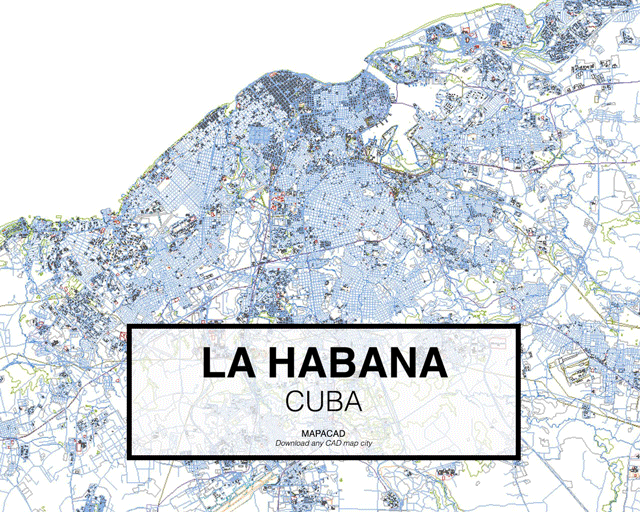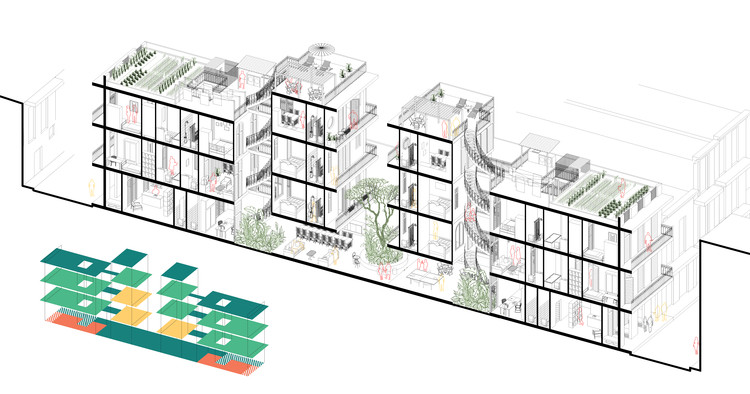
-
Architects: Infraestudio
- Area: 366 m²
- Year: 2022


Infraestudio is an architecture and art practice based in Havana that has been obsessed with fiction since its foundation in 2016. Fernando Martirena, Anadis González, and other members and collaborators work from a narrative and discursive approach to experiment with various resources such as buildings, research, exhibitions, writings, and activism. This has allowed them to operate discreetly in a city frozen in time, recounting how contemporary architecture is done in Cuba today.
For these reasons, Infraestudio was selected by ArchDaily as one of the best new architectural practices of 2023. They are concerned with creating architecture that blends into the landscape, showcasing emptiness as a representation of an idea, focusing not on forms but on strategies, and building with the bare essentials.

Havana has often been referred to as a time machine — a city that transports its visitors to a distant moment and time in history. The capital city’s colorful Spanish colonial-style architecture has made it a go-to destination for photographers, architects, and people seeking life in a bygone era. From classic cars to “its overall sense of architectural, historical and environmental continuity makes it the most impressive historical city center in the Caribbean and one of the most notable in the American continent as a whole,” remarks UNESCO.

The grays of concrete and pollution are not the only representation of cities and towns in the Americas. As perfect postcard material, many cities in the new world express the vibrancy of the people and places through color. HAUS, ArchDaily's partner, has selected five of these cities, which show us how color can bring light to the day-to-day life of cities.

Havana is often referred to as a time machine that transports visitors to a particular moment in history, seemingly frozen in time. While it is a city that boasts an exhaustive timeline of imported styles, Havana in the present day is not defined by a singular historical era—either in its political climate or in its architectural zeitgeist.
Over the decades, the Cuban Revolution has had powerful domestic and international repercussions. In particular, it transformed Cuba’s relationship with the United States. But efforts to improve diplomatic relations have gained momentum in recent years, with the teetering lift of the embargo that exacerbated a David and Goliath situation and left a lasting economic impact on the Cuban people. Havana’s skyline has hardly altered since the fall of the Soviet Union, and the city became shut off from the rest of the world, having to rely heavily on its own resources. Today, the government in Havana occupies the gap between the last stance of post-Cold War communism, and the looming influence of Capitalism, a situation which reveals itself in the variety of distinct architectural styles. These seven sites in the island nation’s capital best explain the story about where Havana has been, and offer a prediction as to where it may head next.

Mapacad is a website that offers downloads of .dwgs of dozens of cities. With 200 metropolises in their database, the founders have shared a set of their most-downloaded cities.
The files contain closed polyline layers for buildings, streets, highways, city limits, and geographical data--all ready for use in CAD programs like Autocad, Rhino, BricsCad and SketchUp.

The largest of the Caribbean islands, Cuba is a cultural melting pot of over 11 million people, combining native Taíno and Ciboney people with descendants of Spanish colonists and African slaves. Since the 1959 revolution led by Fidel Castro, the country has been the only stable communist regime in the Western hemisphere, with close ties to the Soviet Union during the Cold War and frosty relationship with its nearby neighbor, the United States, that has only recently begun to thaw. While the architecture in the capital city of Havana reflects the dynamic and rich history of the area, after the revolution Havana lost its priority status and government focus shifted to rural areas, and the buildings of Havana have been left to ruin ever since. Iwo Borkowicz, one of three winners of the 2016 Young Talent Architecture Award, has developed a plan that could bring some vibrancy, and most importantly some sustainability, back to Havana, the historic core of the city.

For decades, Cuba's communist economic system has essentially outlawed all forms of private architectural work. In 2011 though, wide-ranging economic reforms brought a challenge to this status quo. In this article, originally published on Curbed as "In Cuba, Architecture and Design Blossom Under New Laws," Julia Cooke explores how these laws to bring about a more flexible economic system are allowing a different kind of architecture to emerge.
This May, visitors were allowed into Havana's long-defunct Tallapiedra electric plant for the first time since it was shuttered in the 1960s. They could climb the grated stairs to the plant's nave, see how the light glinted off unchipped white and green tiles set in place in 1915, how tiny, stalky trees had grown out of clumps of dirt where machinery once sat, how the high, church-like central space and the split-level, open workspaces on one side might be adapted to any number of uses. The opening—for locals and some of the thousands of tourists in Cuba for the Twelfth Havana Biennial—was the work of Claudia Castillo and Orlando Inclán, and their eight-year-old think tank, Habana Re-Generación.

For the first time in over a half-century, the United States reopened its official diplomatic embassy in Havana earlier today, shining an international spotlight on Harrison and Abramovitz's modernist shoreline classic. Historically maligned by many Cubans as an embodiment of American arrogance and imperialism, the building has played a pronounced symbolic role in the escalation - and now the easement - of political animosities between the two countries.

Thanks to its privileged position as a gateway to North America and Cuba's unique political history, the architecture of the City of Havana has a rich and layered quality rarely found. In a new book edited by Cathryn Griffith, "Havana Revisited: An Architectural Heritage," this history is explored in detail through 12 essays by renowned architects, historians, scholars, preservationists, and urban planners in both Cuba and the United States and a selection of 350 color images comparing historic postcards with the city of today. The following text is the book's introduction, written by Cuban architect, urban planner and critic Mario Coyula (1935-2014).
Havana’s modest beginnings came in the sixteenth century, as the springboard for Spain’s conquest of America. When the port became the obligatory last American stop for Spanish ships making their return voyages to Europe, its significance grew until Havana had become the most important city in the Gulf of Mexico and the Caribbean. From the beginning, it was a settlement oriented toward providing services, especially that of protection. Hence, Havana became home to the most formidable system of defensive fortifications in the colonial Americas.

The United States’ diplomatic presence in Cuba is housed in a severe, early-1950s office building perched on the shoreline over Havana Bay. Walled off from the city and pulled back from the street, the building has the uneasy presence of a haunted castle – shunned and maligned by its neighbors, but subjected to the unending scrutiny of suspicious eyes and intrigued gossip of the locals. With its regimented orthogonalities and the unmistakably foreign imprint of modernist efficiencies, both the embassy's architecture and the optimistic political spirit it embodies seem to belong to another era, a cooperative past no longer conceivable in the wake of a half century of underhanded diplomacy, calumnious propaganda, and failed attempts to restore relations between the embattled countries.
.jpg?1592594267)
In 1961, Fidel Castro said: “Cuba will count as having the most beautiful academy of arts in the world." The Cuban National Schools of Arts, originally imagined by Castro and Che Guevara, are perhaps the largest architectural achievements of the Cuban Revolution. The innovative design of the schools, which aimed to bring cultural literacy to the nation, encapsulated the radical, utopian vision of the Revolution.
Unfortunately, the nation’s idealistic enthusiasm lasted for a fleeting moment in time and the Schools quickly fell out of favor; they were left to decay before even being completed. Today, following nearly four decades of neglect, the architects have returned to try and bring these derelict schools back to their intended glory.